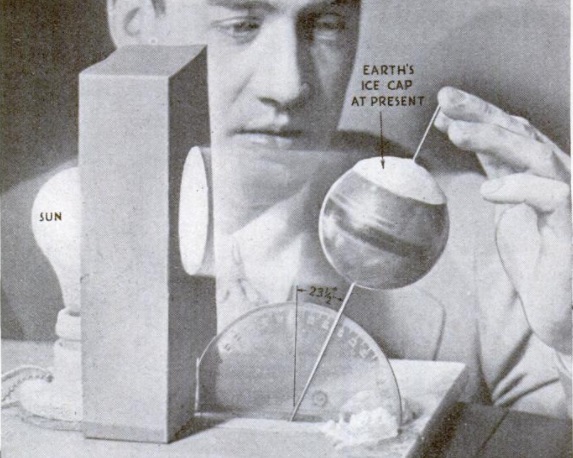 If Junior wants to perform a somewhat contrarian and controversial science fair experiment, he or she can perform an experiment to answer the following question:
If Junior wants to perform a somewhat contrarian and controversial science fair experiment, he or she can perform an experiment to answer the following question:
“Can global warming be caused by reduction in the obliquity of the ecliptic?”
The science teacher won’t be able to react immediately, because he or she probably doesn’t know what “obliquity of the ecliptic” is. But after they consult Wikipedia, they’ll understand the concept, and they might have to grudgingly concede that there’s something to it. “Obliquity of the ecliptic” is just a fancy term for the angle at which Earth’s axis of rotation is tilted. Today, it’s about 23.4 degrees. But 8000 years ago, it was 24.2 degrees, and it’s been going down ever since.
 With this experiment from 85 years ago, Junior will be able to demonstrate that as the tilt decreases, the ice pack at the poles will increase. In the illustration above, the Earth is covered with “ice” to about the same extent that it is today–it’s north of the Arctic Circle. But if the tilt is increased, the extent of the ice pack covers much more of the hemisphere, as shown at left.
With this experiment from 85 years ago, Junior will be able to demonstrate that as the tilt decreases, the ice pack at the poles will increase. In the illustration above, the Earth is covered with “ice” to about the same extent that it is today–it’s north of the Arctic Circle. But if the tilt is increased, the extent of the ice pack covers much more of the hemisphere, as shown at left.
The experiment to demonstrate this appeared in Popular Science 85 years ago this month, November 1936. The Earth is represented by a rubber ball. A hole is drilled through the center and a knitting needle is inserted, to serve as the axis. The earth is then dipped in melted paraffin wax and covered to a depth of about 1/16 inch, representing ice. A high-wattage light bulb serves as the sun, and the ball is mounted as shown and rotated. After about a half hour, a layer of wax covers the area north of the Arctic Circle. The remaining wax drips off onto the mounting board. In the real world, this melted ice would enter the oceans.
The experiment is then repeated with a larger angle, and the “ice” covers much of the hemisphere. Junior has demonstrated that the extent of arctic ice increases as the obliquity of the ecliptic increases, and decreases as the obliquity of the ecliptic decreases. Since the obliquity of the ecliptic is currently decreasing, it stands to reason that this is a cause of the arctic ice decreasing. And if the teacher believes that some other cause is at work, then he or she can come up with an experiment. Junior can remind the teacher that this is how science works.
